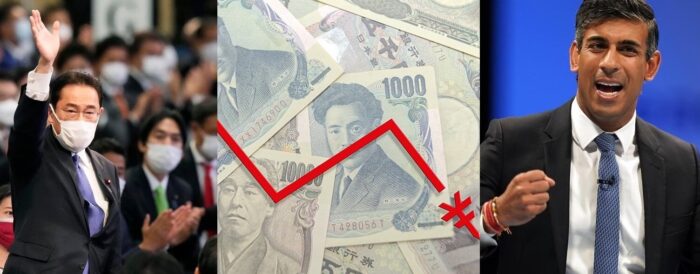Published in Japan Forward 27th October 2022
Once upon a time Japan stood out for its rapid turnover of prime ministers, whereas British politics was generally stable, with leaders Margaret Thatcher and Tony Blair holding office for eleven and ten years respectively.
No longer. Rishi Sunak has just become the UK’s fifth prime minister in six years, and Chancellor of the Exchequer Jeremy Hunt is the fourth person to hold the position this year. As was usually the case in Japan, all this turbulence at the top happened not because of a change of government, but while the same party was in power.
Meanwhile, the Japanese yen has fallen sharply on the foreign exchange market against the rampant US dollar, from 115 at the start of the year to 150 in late October.
At first sight, these two phenomena seem to be entirely unrelated, but political and financial instability often go together. It was during Japan’s “lost decades” of deflation and banking crises that prime ministers came and went so quickly that it was hard to keep track.
On the other hand, good financial conditions often coexist with political stability. Over the past forty years, there have been twenty one Japanese prime ministers, but only three served lengthy terms in office – Yasuhiro Nakasone (1982-87), Junichiro Koizumi (2001-6) and Shinzo Abe (2012-20). It is no coincidence that powerful bull markets took place during their stints in power.
The Japanification of British politics is happening because political leaders are as helpless in the face of the challenges they face as Japanese politicians were in the 1990s. The choices are between bad and very bad.
But Britain is hardly alone in its predicament. More or less the entire Western world adopted the super low or negative interest rate regime that came into favour after the Global Financial Crisis of 2008. Likewise, most of the world has experienced a sharp rise in inflation caused by the “free money” that central banks handed out to cushion the effects of Covid restrictions. Now we have the blowback.
The shift from near-zero interest rates to 4.5%, in the case of a two year U.S. bond, has been stunningly fast by the standards of monetary policy. The result has been an extraordinary surge in the value of the dollar. In terms of the real effective exchange rate – which takes inflation into account and measures against the currency of all trading partners – the dollar has only been stronger than it is now 3% of the time since the dawn of floating currencies in 1971.
It takes a year or more for monetary policy to have its full effect on an economy. The inflation gripping the world today is the result of actions that the world’s central bankers took in 2020 and 2021. Despite all their experience and the intellectual resources at their disposal, they didn’t see it coming. Are they now making the reverse mistake – tightening too fast and driving the world economy into a nasty recession? It’s quite possible.
After the Global Financial Crisis, the world was pulled out of slump by double digit growth in the Chinese economy and explosive mass demand for mobile devices. We may not be so lucky the next time around. Indeed, there are three new problems that will complicate the already tortuous task of crushing inflation without crushing growth.
The first is the hardening confrontation between China and the United States and its allies. Recent events such as America’s adoption of much tougher restrictions on tech exports and the removal of moderates and pragmatists from the upper reaches of the Chinese Communist Party would seem to put the two countries on a collision course.
Secondly, the Ukraine war is evolving into a proxy war between Russia and the United States in which neither side can afford to back down, with obvious implications for energy costs.
Thirdly, Japan and several other countries are going to find it immensely difficult to meet the “net zero carbon footprint” commitments that their governments have made.
In this treacherous economic landscape, nobody looks good but Japan’s weak yen is a tiny problem, if indeed it is a problem at all. Yes, Japan’s consumer price index is currently rising at 3.0%, but that massively overstates the outlook. Market expectations – as measured by the difference in yield between regular government bonds and those that are protected from inflation – are for annual inflation of a mere 0.9% over the next ten years. In other words, the consensus of investors, as revealed by their actions, is that the Bank of Japan is nowhere near hitting its target of 2% inflation on a sustainable basis.
So what should Japan do about the yen? The answer is nothing. In fact, it should stop intervening in the currency markets, which rarely has any lasting effect and, by reducing the available supply of yen, constitutes a tightening of monetary policy.
Significant currency movements always create winners and losers. Inevitably, the losers complain loudly while the winners count their profits and keep quiet.
In the case of the weak yen, the winners are exporters and global companies – in other words, Japan’s blue chip champions. Yet, such is the competitive edge that the severely undervalued yen creates that smaller companies may find it worth their while to venture into overseas markets too. In what is likely to be a tough and volatile economic environment, the weak yen could turn out to be a blessing.
There is always a possibility that the central banks successfully soft-land the global economy and political stability is restored, but it seems unlikely. As to which prime minister lasts the longer, Fumio Kishida or Rishi Sunak, I would put my money on the former.
